
I went to Spain from Wed 29 April to Tue 05 May, flying into Madrid and using trains for ground transportation.
My hotel in Madrid was far to the North of the city center, about half an hour by metro. I only had three trips to the city center throughout my stay, so I felt it was worth it, considering it was half the price of the more central hotels. Thursday morning I took the metro downtown, walking around the historic center of Madrid. I didn't bother to wait in line at the royal palace, but I visited the Cathedral. I was very impressed by the ceiling. This cathedral has white walls and a multicolored ceiling with really bright colors.
Next I visited the bullfighting arena at Ventas. This is a very nice building with Moorish-style arches and a bullfighting museum. I figured there's not that many bullfighting museums around, so I checked it out. It had a range of exhibits featuring famous bullfighters' suits, stuffed heads of particularly brave bulls and bullfighting equipment. It was pretty small, and the museum smelled funky from being located above the stables of the bullring, but it was different, and free.

There's a couple of must-sees in Madrid, and those are the Reina Sofia museum and the Prado museum. The Reina Sofia has contemporary art, while the Prado has classical art.
The Reina Sofia museum wasn't that interesting to me. It had a messy presentation, lots of sections were closed off, so the posted museum maps were incorrect. Some of the sections I wanted to visit were closed off. Also, there were long lines to see the famous "Guernica"-painting by Picasso. I guess most people were there just to see that one.
The first thing that struck me about the Prado, was the disorganized entry hall. You had to go one place outside for tickets, then to the coat-check, then line up for security, but there was not all that much in the way of signs, so there were plenty of confused tourists around. There were lots and lots of tourists, the whole place felt crowded. Not as crowded as the Louvre, though. I spent my time there looking at the Goya paintings and the ones by the Dutch painters.
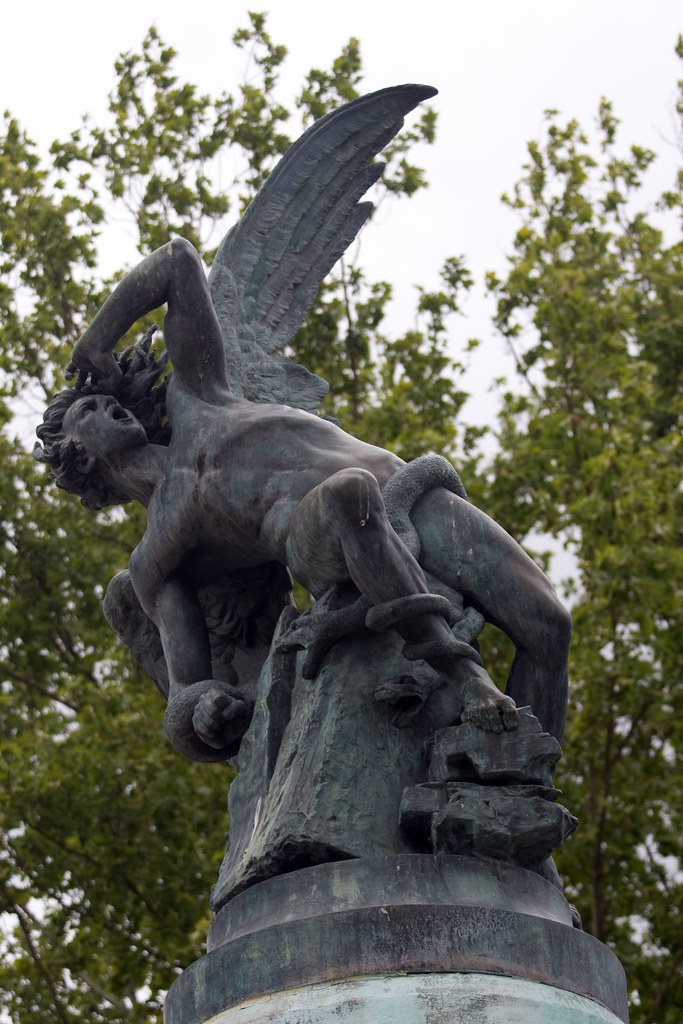
Next I walked around the park and stopped to look at the Satan-statue. The statue of the "Angel Caido" is supposedly the only public statue of Satan in Europe. The statue could have been cooler, though. He looked just like a regular angel, with some snakes added to make him look bad.
In the evening, I had my dinner at an "American Restaurant" downtown (Yes I know, tourist trap, but sometimes it's nice if the waiters speak English). Interesting to have coleslaw served with your steak, but in general the food sucked. I had a really horrible piece of meat that was supposed to be sirloin. Guess I should have gone outside the touristy districts for my dinner.
Friday morning I took the train to Granada. First time I had to go through security lines to use the train. Then again, after the terrorist train bombings of 2004, I can see why they're being careful. There was limited public transport in Granada, so there were huge lines for the taxis. Also, there were no taxi attendants, and people cut in line like crazy. I notice cutting in line seems to be a very Spanish thing, almost everywhere where there's a line I see people trying to cheat. I almost got in a fight with one guy that stole my taxi. I found this puzzling, the guy was willing to fight to spend about one minute less waiting for a taxi. Sober and in broad daylight...
I finally got to my hotel and walked up to the ticket office at Alhambra to pick up my ticket for the next day. I spent the afternoon walking around the old Arab neighborhood of Albayzin. There were lots of tourists walking around, but then again, Granada is one of the top tourist destinations in Spain, and this was a public holiday. I noticed most of the tourists were Spanish.

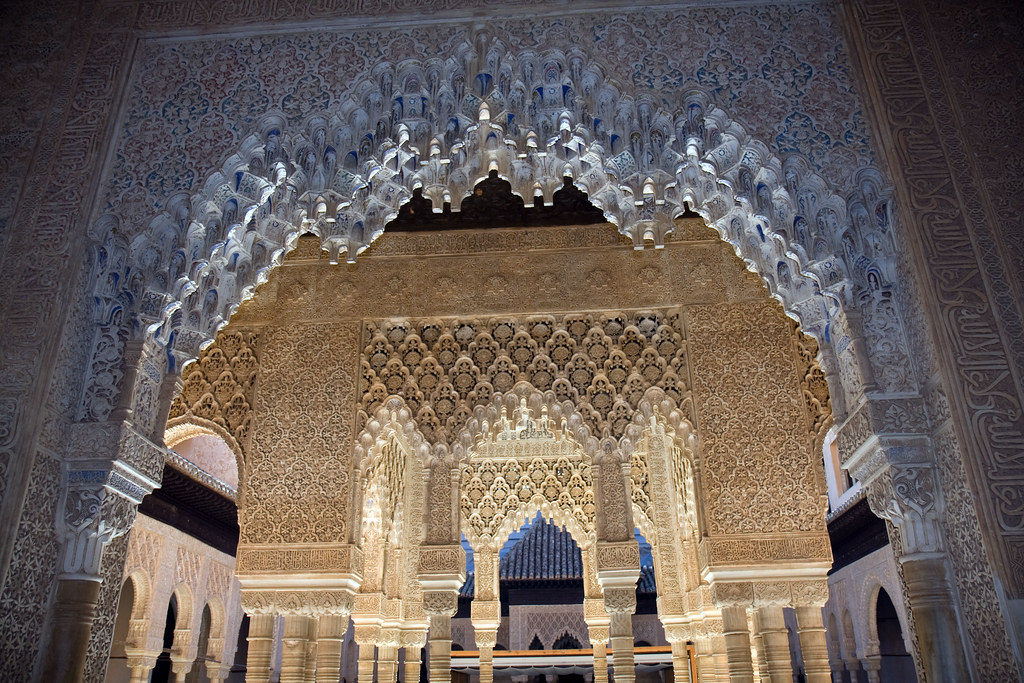
Saturday I got up really early and made my way up to Alhambra. Alhambra (from Al-Ambra, "The red one", or "The red fortress") was the final outpost of the Moors in Europe, and it is one of the main tourist attractions of Spain. It's a fortress containing the palaces of the Nasrid rulers and a huge garden (Generalife).
I got up there around 8 and I was almost alone in the fortress. It was pretty neat walking around the area with almost no other tourists around. For entry to the palaces they have time-stamped tickets, because they only let in 300 at the time. This is a good thing, because they estimate 8000 tourists visit the site every day, and throughout the year they have over 2 million visitors. Even with the restrictions, it was pretty cramped inside the palaces. The inscriptions on the walls and arches were very interesting, and so different from decorations in other palaces I've been to. I must say the experience was not that great because the place was so crowded. You have a very good view from the towers of the fortress. On one side you can see Granada below and the picturesque Albayzin-district, and on the other you see across the gardens towards the snow-covered Sierra Nevadas. I just had to snap a photo of having both palm trees and snow-covered mountains in the same view. Not too many places in the world you can do that... The Generalife gardens were pretty boring, just a bunch of trees and some rose gardens. I suppose I was there at the wrong time of year, maybe it's better later in the summer.
I spent the afternoon walking around the Albayzin, and had a crappy dinner at an outdoor restaurant. I don't know how I keep picking bad restaurants. I spend a lot of time doing it too, so it's usually easier if I travel with someone and just let them pick. Also, eating alone at restaurants sucks, so I try not to do it too much.
Sunday I got up really early and got on the train to Sevilla. I had a very good view of the Andalucian landscape from the train. At first you see very red soil and cacti along the side of the train track. The whole area reminded me of Sedona, and I can see why they chose this area to make western movies. Further to the east of Granada is the desert where they made the classic spaghetti-westerns like "The Good, the Bad and the Ugly" and "For a fistful of dollars". As you get closer to Cordoba, you see endless rows of olive trees, filling the rolling hills as far as the eye can see. Also, dotted around the landscape are small villages of white houses, sometimes with a fortress on a small hill nearby. Getting closer to Sevilla, you start seeing palm trees and flocks of bulls grazing. This is where they breed the fighting bulls for the corrida.
My hotel was in the city center of Sevilla, so it was pretty convenient for walking around downtown. I visited the Real Alcazar, the royal fortress, which had a lot of the same types of decorations as they had in the palaces of the Alhambra. I liked the Alhambra more. There's some fairly big royal gardens outside. Looks like Sevilla gets a lot more international tourists , you hear people speaking English or French around you everywhere you go. It was a lot hotter in Sevilla than in Granada, afternoon temperatures were around 32-34 degrees celsius.
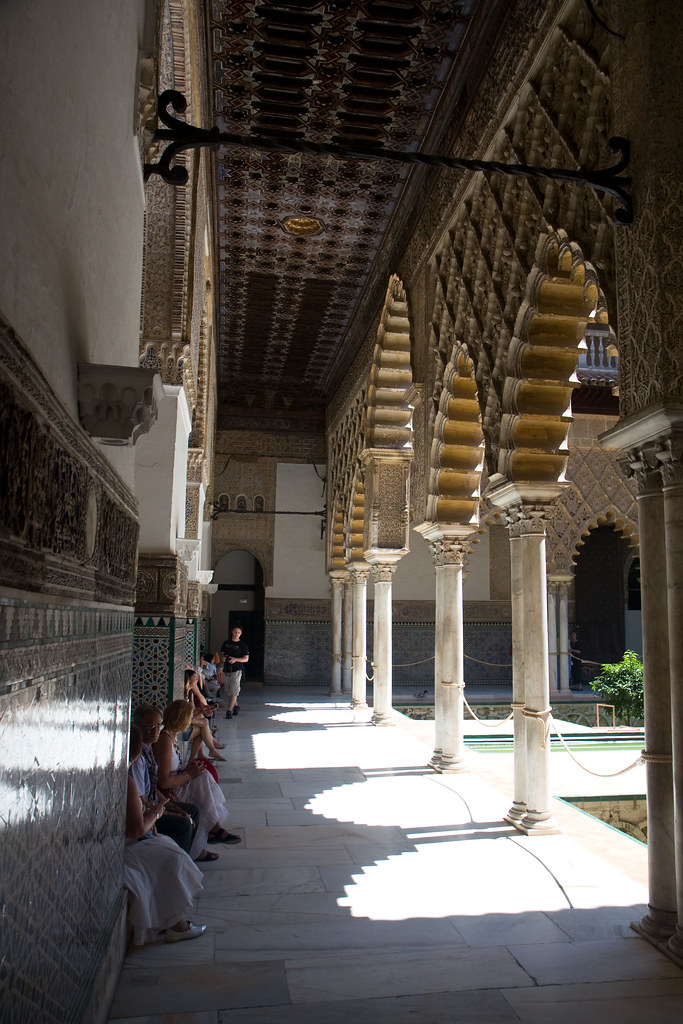


In the afternoon I went to see a bullfight at the famous Maestranza bullring. It was a lot more entertaining than I had expected, mostly because of the audience, with lots of back-seat toreadors shouting comments. This was the last bullfight of the spring festival (Feria de Abril), and it looked like they had some big-name matadors on the bill, so it was a full house, with TV cameras and press photographers. The star matador opened the show with an apparently stellar performance, and he received standing ovations from the crowd after the fight. In total there were three matadors fighting two bulls each, so six fights in total.
Each fight starts with fanfares as they let in an angry, confused bull. Then a bunch of guys with big pink capes run around and try to piss off the bull as much as possible. Next, there's more fanfares and they bring in a guy on horseback with a pike (a picador). They provoke the bull into charging the guy on the horse, and the picador rams his pike multiple times into the shoulder muscles of the bull. Now the bull is angry and wounded, and some guys run in with small colored spears (banderillos) , which they ram into the shoulders of the bull, usually with some flamboyant gestures and shouting as they stretch their arms into the air after stabbing the bull.
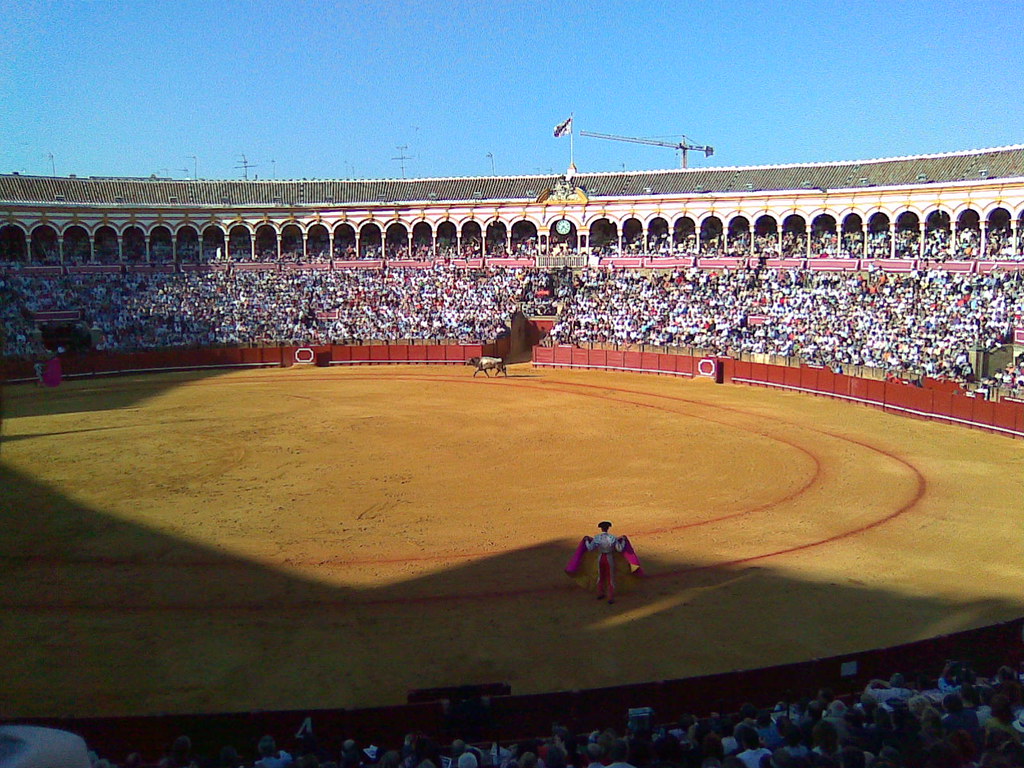
Then the matador emerges with the red cape. He provokes the bull by shouts and shaking the cape to make the bull charge the cape. He then swings the cape away just as the bull charges, or pulls it forwards and upwards, following the movements of the horns. Making the cape follow the horns up looks like the difficult part, as only the star matador was able to do it consistently, and the crowds were shouting "Olé!" every time he did it. This goes on for a while, and then the matador walks to the ringside to get his killing sword. He then makes the bull do a few more passes before he tries to stab the sword between the shoulder blades of the bull, trying to puncture the bull's heart. In some of the fights this was done, and the bull ran around for a while, before collapsing to the ground. Then one of the assistants would run up and kill the bull with a quick dagger thrust to the back of the head. The star matador did things differently. After ramming the sword between the shoulder blades of the bull, he picked up a different sword, used the cape to make the bull lower its horns and then made a quick thrust to the head with the sword, killing the bull instantly. The bull was then dragged out of the ring by four horses, while the orchestra played music.
In one of the fights, the matador had a good performance, so the crowd was waving white handkerchiefs and pieces of clothing at him, and he got the ear of the bull as a trophy. He then paraded the ring while people threw trophies at him. Someone threw a live rooster into the ring, to roars of laughter from the crowd. It took the groundskeepers a while to chase down the rooster to get it out of the ring. Also, in one of the fights, a spectator charged into the ring with a red cape, wanting to take on the bull himself. He managed a few passes before he was escorted off the field. They then switched bulls, tricking the other one into leaving by bringing a herd of bulls into the ring.
This was the first time I had ever been to a bullfight, and it was certainly an experience. It's obviously very important to the Andalucian culture. It's also the first time I go to a blood-sport event, where one of the participants doesn't leave alive. I accidentally stumbled onto watching the dead bulls from the previous performance being loaded on a truck by a forklift. It was a bit grisly to watch.
I can't help but feel sorry for the poor horses they use for the picadors. They have their vocal cords cut, to stop them from whinnying in fear when the bulls gore them, and they are blindfolded, to stop them from seeing when the bull charges. They have some sort of body armor to stop them from being seriously injured by the bull, but I can imagine it is no fun being gored by an angry bull.
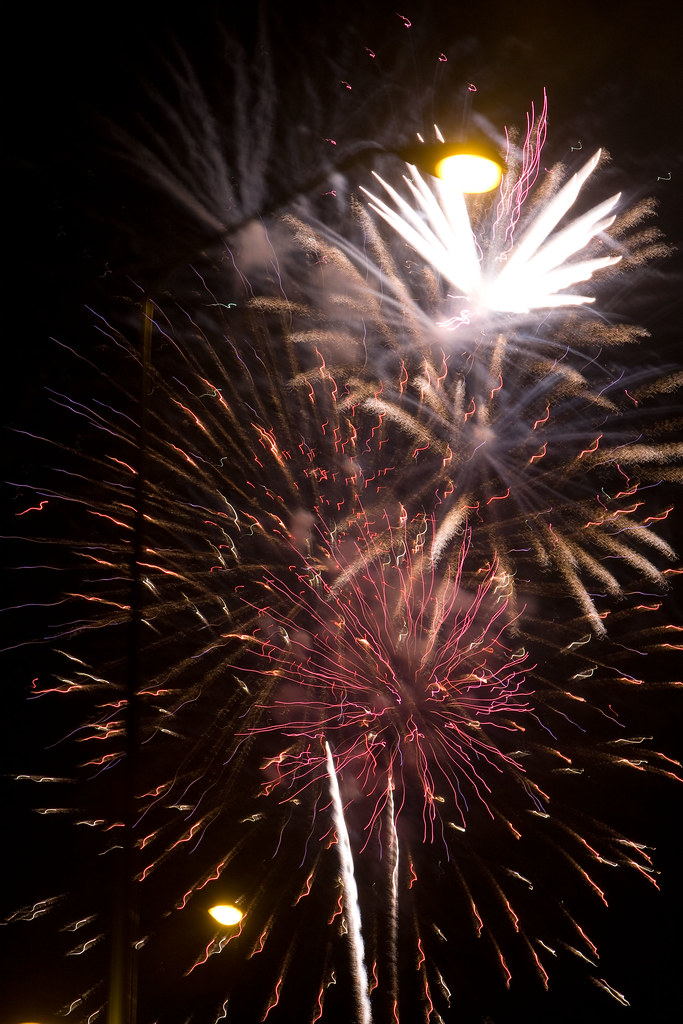
This day was the end of the Feria de Abril (the spring festival), so around midnight I made my way down to the river bank. There I witnessed the most spectacular fireworks display I have ever seen. It was a huge, professional setup, and it went on for 15 minutes or so. I was only pissed off that I forgot to bring my gorilla-pod, so all my photos had to be hand-held. There was a big crowd of mostly young people watching, mostly local students, cheering and clapping. I had a good time.
Monday was a bit of an anticlimax after the eventful day I had the day before. I walked around the narrow streets of the touristy Santa Cruz district, before getting in line to get into the cathedral. The cathedral wasn't worth the wait, and certainly not the 8 euros they charged for entry. You get to go up to the top of the Giralda bell-tower, but Sevilla isn't that much to look at from above. I spent the rest of the day shopping, walking along the river bank and looking at the Torre del Oro (Moorish tower that defended the city) and Plaza de Espana. In the evening I had dinner at a nice restaurant close to the cathedral, finally having found a good one.
Tuesday I traveled back to Holland, taking the train from Sevilla and flying out of Madrid.
Madrid didn't have all that many attractions, and I was struggling to fill even a single day. Granada was OK, but crowded, and except for the Alhambra and the Albayzin, it doesn't have all that many attractions. Sevilla had a lot of attractions, lots of good restaurants, good shopping and lots of things to do. Also, the climate was more pleasant in Sevilla, than Madrid. I like warm places, so this was a nice change from rainy Holland. Being Norwegian, I have spent too much time in cold places. In general I liked Sevilla the most.
Pictures from Madrid
Pictures from Granada & Sevilla